For phase contrast imaging, you’ll need a C-Mount adapter specifically designed for phase contrast objectives to maintain proper optical alignment. Choose adapters with pre-centered phase sliders that eliminate re-centering during use and are compatible with your microscope’s standard ring slits for 10x, 20x, and 40x objectives. A 2X magnification adapter generally provides the best resolution and detail. Match the adapter to your microscope model and camera type for ideal light transmission and image clarity. The right setup makes all the difference.
Understanding Phase Contrast Imaging Requirements for Camera Adapters
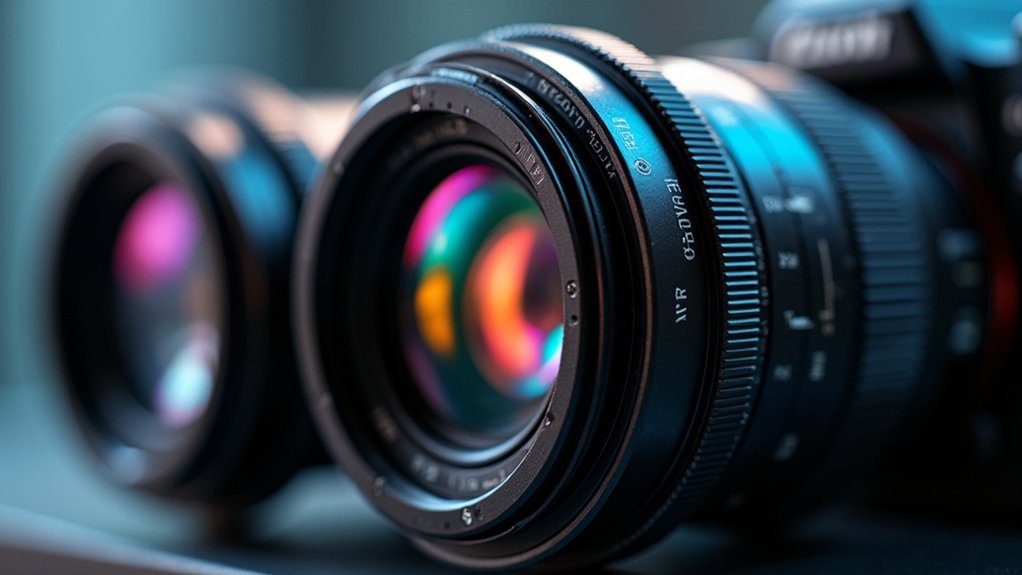
When selecting camera adapters for phase contrast imaging, you’ll need to prioritize specific technical features that guarantee ideal results.
Look for adapters with pre-centered phase contrast sliders that eliminate re-centering during use, ensuring consistent image quality throughout your sessions.
Choose adapters featuring standard ring slits compatible with 10x, 20x, and 40x magnification objectives. These are essential for capturing detailed phase contrast images.
Pair your setup with high-resolution camera sensors that detect subtle differences in optical density characteristic of phase contrast specimens.
Your microscope should include a trinocular tube option, allowing simultaneous viewing and imaging without compromising observation.
Modern cameras with remote control capability and live view mode with magnification functions will greatly improve your focusing precision and adjustment capabilities.
Essential Components of Camera Adapters for Phase Contrast Microscopy
When selecting camera adapters for phase contrast microscopy, you’ll need to evaluate their optical path features, which should maintain light coherence while minimizing aberrations.
Your adapter must be compatible with your microscope’s mounting system, whether it uses C-mount, T-mount, or microscope-specific connections.
These compatibility considerations guarantee proper alignment between your camera and microscope, critical for capturing the phase differences that make cellular structures visible.
Optical Path Considerations
Understanding the optical path structure is fundamental to selecting the right camera adapter for phase contrast microscopy. Your adapter’s optical path must precisely match the magnification objectives (10x, 20x, 40x) you’re using to maintain ideal image quality and preserve specimen detail.
When evaluating camera adapters for phase contrast work, prioritize those supporting high pixel counts and excellent ISO sensitivity. These features allow you to capture transparent specimens without staining while revealing essential structural details.
The best adapters include pre-centered phase contrast sliders that eliminate tedious re-centering and guarantee accurate imaging results. Choose high-quality C-Mount adapters specifically designed for phase contrast objectives, as they provide the precise alignment necessary for this technique.
Modern adapters compatible with remote control functionality will give you greater flexibility during complex imaging sessions.
Mounting System Compatibility
Selecting the right mounting system represents the cornerstone of successful phase contrast imaging, as incompatible adapters will render even the finest microscopes ineffective. Your adapter must match your specific microscope model to guarantee proper optical alignment and image quality.
Most phase contrast camera adapters feature a standard 1″ (25.4mm) mechanical size designed to connect securely to your microscope’s photo port or trinocular head.
When choosing an adapter, consider these critical compatibility factors:
- Microscope model-specific mounting requirements
- Pre-centered phase contrast sliders that eliminate manual re-centering
- Support for both DSLR and mirrorless cameras
- Integration with LM digital adapters for peak image quality
- Specialized optics that enhance the contrast between transparent specimens and backgrounds
The right mounting system guarantees your optical system maintains the unique requirements of phase contrast microscopy throughout the imaging process.
C-Mount Adapters: Optimal Solutions for Phase Contrast Photography
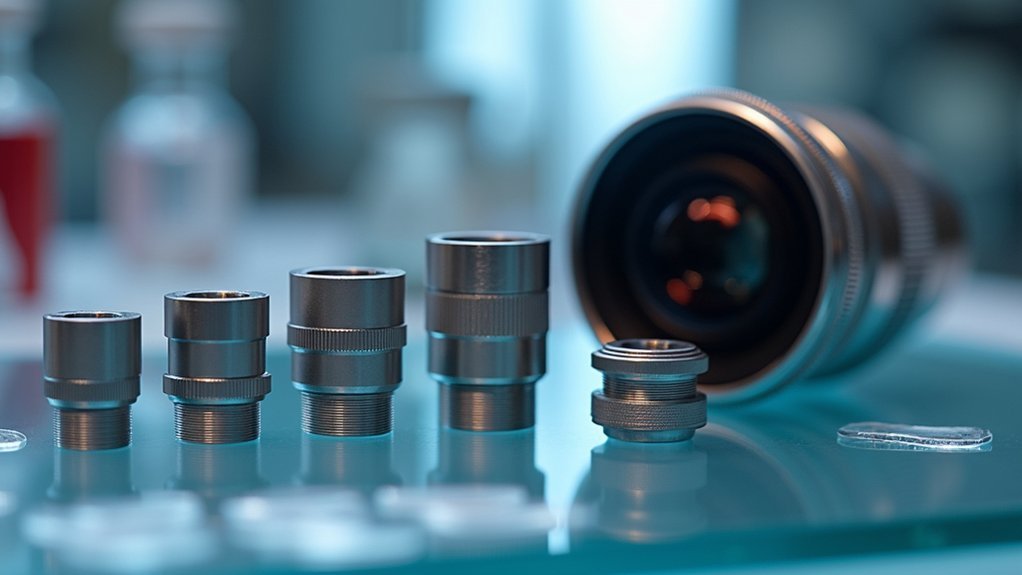
Because phase contrast imaging demands exceptional clarity and precision, C-Mount adapters have emerged as the industry standard for connecting digital cameras to microscopes. These adapters feature a universal 1.00″-32 (25.4mm) mechanical connection that works across multiple microscope brands.
When selecting your adapter, you’ll need to match the internal optical lens to your camera sensor size for ideal results. Proper alignment and calibration with your microscope’s phase contrast components will guarantee the highest image quality, especially at higher magnifications.
| Adapter Feature | Benefit | Application |
|---|---|---|
| Internal optics | Enhanced detail | Fine structures |
| Sensor matching | Full-field clarity | Whole specimen views |
| Precise alignment | Artifact reduction | High-magnification work |
Remember that these adapters effectively transfer what you see through your eyepieces directly to your digital camera, maintaining the contrast and resolution required for professional phase imaging.
DSLR and Mirrorless Camera Adapters for Phase Contrast Applications
For phase contrast applications, you’ll find universal T-mount options that connect virtually any DSLR or mirrorless camera to microscopes like the Olympus CKX41.
C-mount adapter solutions provide the highest optical quality with plan achromatic designs that preserve resolution and clarity while eliminating the need to re-center your phase contrast slider.
Brand-specific integration systems, tailored for manufacturers like Canon, Nikon, and Sony, guarantee peak performance with your camera’s high pixel count and ISO sensitivity for capturing transparent specimens.
Universal T-Mount Options
The universal T-Mount adapter represents one of the most versatile solutions for connecting your DSLR or mirrorless cameras to phase contrast microscopes.
These adapters feature standard M42-75 threading, ensuring compatibility across multiple camera brands while maintaining perfect optical path alignment for your imaging work.
When choosing T-Mount adapters for phase contrast imaging, consider these key benefits:
- Seamless integration with various camera models through universal design
- Precision-engineered construction that minimizes distortion
- Maximum light transmission for high-resolution images
- Adjustable features for fine-tuning focus and alignment
- Perfect sensor alignment with the microscope’s optical path
You’ll achieve superior results in phase contrast microscopy with these adapters, as they’re specifically designed to maintain image quality while providing the flexibility needed for different equipment combinations.
C-Mount Adapter Solutions
Precision C-Mount adapters serve as critical bridges between your DSLR or mirrorless camera and phase contrast microscopes, delivering exceptional image fidelity through the trinocular head.
These specialized connectors guarantee that the detailed phase contrast images you observe through eyepieces are accurately transferred to your camera’s sensor with optimal enlargement.
When selecting a C-Mount adapter for your setup, you’ll need to match the optical lens inside the adapter to your specific camera sensor size.
This compatibility is essential for maintaining image quality and preventing vignetting.
Pay close attention to the back focal length specification, as this determines how effectively the adapter will perform with your particular microscope model.
Many manufacturers offer brand-specific C-Mount configurations that enhance compatibility and maximize performance for phase contrast imaging applications.
Brand-Specific Integration Systems
Leading manufacturers have developed specialized integration systems that perfectly match their proprietary phase contrast equipment, guaranteeing you’ll achieve ideal results without compatibility issues.
When selecting camera adapters for phase contrast microscopy, consider systems like Olympus CKX41 with pre-centered phase contrast sliders that eliminate manual adjustments.
LM digital adapters are particularly valuable for high-quality image capture as they properly align the optical path for maximum light transmission through phase rings.
- Compatible with various magnification levels (10x, 20x, 40x)
- Offers remote control capability for vibration-free imaging
- Features live view mode for real-time specimen monitoring
- Provides good ISO sensitivity for low-light conditions
- Guarantees proper connection to trinocular heads or photo/video ports
Choose adapters that match your microscope’s specific connection sizes for perfect alignment and performance.
Adapter Magnification Factors: Choosing the Right Ratio for Phase Imaging
Selecting an appropriate magnification factor for your camera adapter represents a critical decision when setting up phase contrast imaging systems. The 2X adapter is widely preferred for its ideal resolution and detail preservation when capturing phase contrast images.
You’ll need to match your adapter’s magnification ratio with your objective lens—for example, pairing a 40x objective with a 2X adapter guarantees maintained image quality and clarity.
When working with standard 10x, 20x, and 40x magnifications, you’ll require a standardized ring slit for proper alignment. High-quality adapters that minimize chromatic aberration are essential for producing sharp images across different magnifications.
Don’t overlook the importance of a snug fit—your adapter must integrate seamlessly into the microscope’s optical path to prevent light leakage that would compromise your phase contrast results.
Compatibility Guide: Matching Adapters to Your Microscope Model
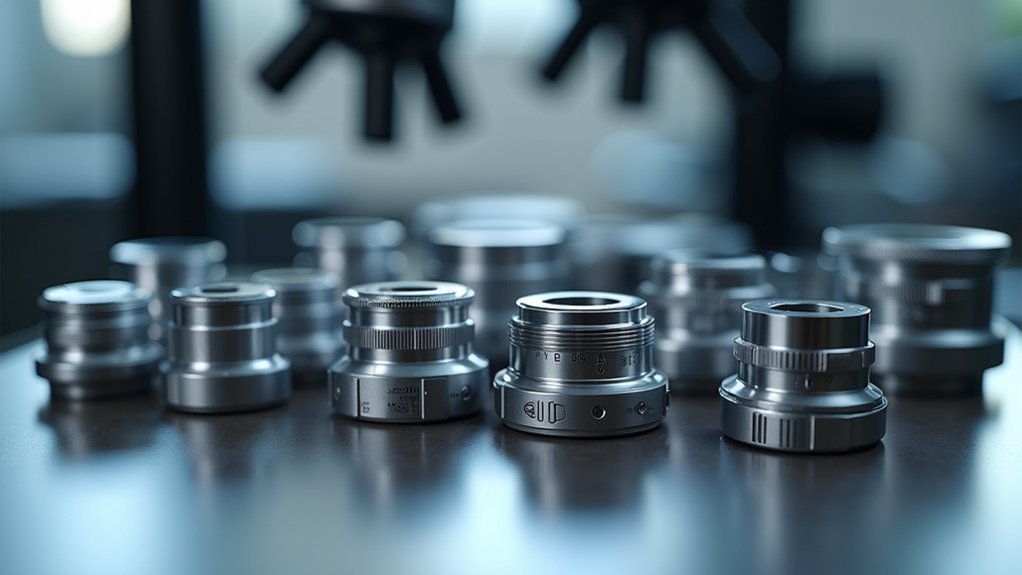
Finding the right camera adapter for your phase contrast microscope requires careful attention to size-specific fitting options, with standard diameters of 23.2mm, 30mm, and 30.5mm being the most common choices.
When working with the Olympus CKX41 model, you’ll need LM-compatible adapters that connect seamlessly to the trinocular port without compromising image alignment.
Your trinocular compatibility is essential for successful phase contrast imaging, as proper centering and stability between the camera and microscope will directly impact your ability to capture clear, high-contrast images.
Size-Specific Fitting Options
When you’re matching camera adapters to your microscope for phase contrast imaging, the exact dimensions become critical for both functionality and image quality. Your adapter must align perfectly with the phase contrast slider to deliver peak performance.
Most microscopes require specific eyepiece diameter measurements for proper compatibility:
- 23.2mm – Common in student and entry-level research microscopes
- 30mm – Found in mid-range laboratory equipment
- 30.5mm – Typical in advanced research microscopes
- Camera-specific models like AmScope CA-NIK-SLR for Nikon cameras
- Universal adapters with adjustable fittings for multiple camera types
Check your microscope’s specifications before purchasing, as using an incorrectly sized adapter can compromise the alignment needed for phase contrast imaging and reduce the clarity of cellular structures you’re trying to observe.
Olympus CKX41 Adapter Selections
The Olympus CKX41 microscope stands out as a versatile platform for phase contrast imaging, primarily due to its extensive compatibility with LM digital adapters.
You’ll appreciate how these adapters accommodate DSLR, mirrorless, and C-mount cameras for high-quality imaging applications.
When selecting camera adapters for your CKX41, choose options that support the standardized ring slit for phase contrast magnifications (10x, 20x, and 40x).
The pre-centered phase contrast slider eliminates re-centering concerns, ensuring ideal alignment with your chosen adapter.
For maximum flexibility, opt for the trinocular tube configuration, which allows you to use both eyepieces and camera adapters simultaneously.
Always secure your adapter with the provided rubber O-ring for a proper seal and stable imaging performance.
Trinocular Compatibility Essentials
Building on the benefits of the CKX41’s trinocular configuration, successful phase contrast imaging depends on proper microscope-to-camera connections.
When selecting camera adapters for your trinocular microscope, you’ll need to verify compatibility with your specific model.
- Verify your adapter matches the trinocular head dimensions (typically 23.2mm-30.5mm)
- Confirm your chosen adapter works with your camera model (DSLR, mirrorless, etc.)
- Look for adapters with multiple mounting options for greater flexibility
- Consider LM digital adapters for enhanced integration and image quality
- Choose adapters specifically designed for phase contrast imaging applications
The dedicated photo port on trinocular microscopes provides ideal image projection, but only if properly matched.
Don’t compromise your phase contrast imaging quality with incompatible equipment—verifying dimensions and specifications before purchase will save time and guarantee superior image capture results.
Image Quality Considerations When Selecting Phase Contrast Adapters
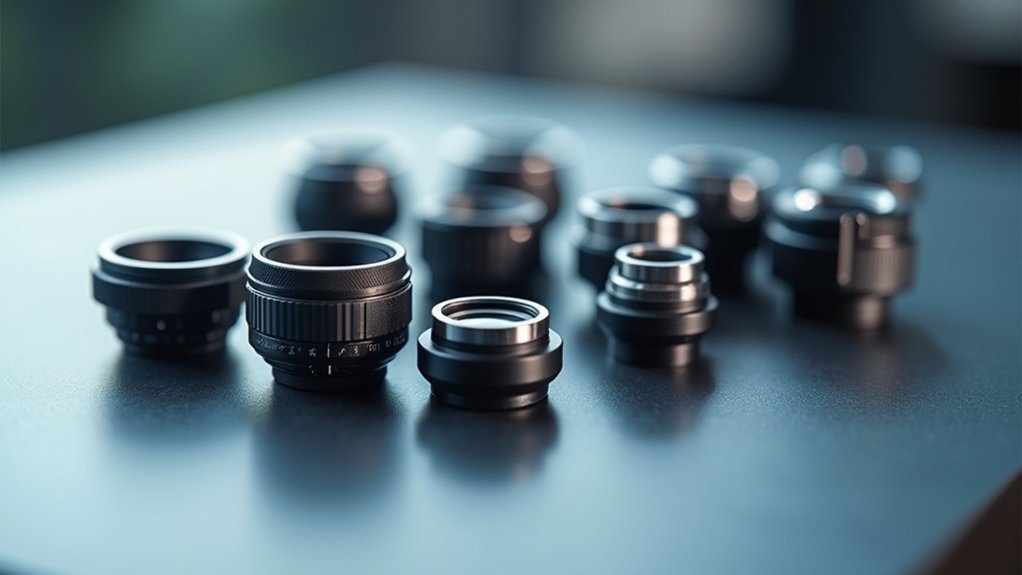
Selecting the right phase contrast adapter directly impacts your microscopy results, as optical integrity throughout the imaging pathway determines final image clarity.
When evaluating adapters, look for those that minimize chromatic aberration while maintaining high optical quality throughout the light path.
Your adapter’s magnification power (typically 2X) should complement your microscope’s objectives to achieve ideal resolution. A pre-centered phase contrast slider eliminates the need for frequent adjustments that could compromise image quality.
Don’t overlook camera sensor specifications—higher ISO sensitivity can dramatically improve your results in the low-light conditions common in phase contrast work.
Additionally, verify your adapter includes standardized ring slits that match your magnification levels (10x, 20x, 40x) for consistent performance across all objectives you’ll use in your imaging workflow.
Trinocular vs. Phototube Adapter Options for Phase Contrast Work
When configuring your phase contrast microscopy system, choosing between trinocular and phototube adapters represents a fundamental hardware decision that shapes your workflow and imaging capabilities.
Trinocular adapters offer the advantage of simultaneous viewing and imaging, preserving your visual experience while capturing phase contrast images.
- Trinocular adapters include dedicated photo ports compatible with various camera types
- Phototube adapters connect cameras directly to the optical system for minimal light loss
- Both adapter styles must match your specific microscope model for ideal alignment
- Trinocular setups accommodate DSLRs and mirrorless cameras for flexible imaging options
- Phototube adapters may feature adjustable diopters for enhanced focus refinement
Consider your imaging performance needs when selecting—trinocular adapters excel in teaching environments while phototube options often deliver streamlined performance for dedicated imaging work.
Budget-Friendly Adapter Solutions Without Compromising Image Quality
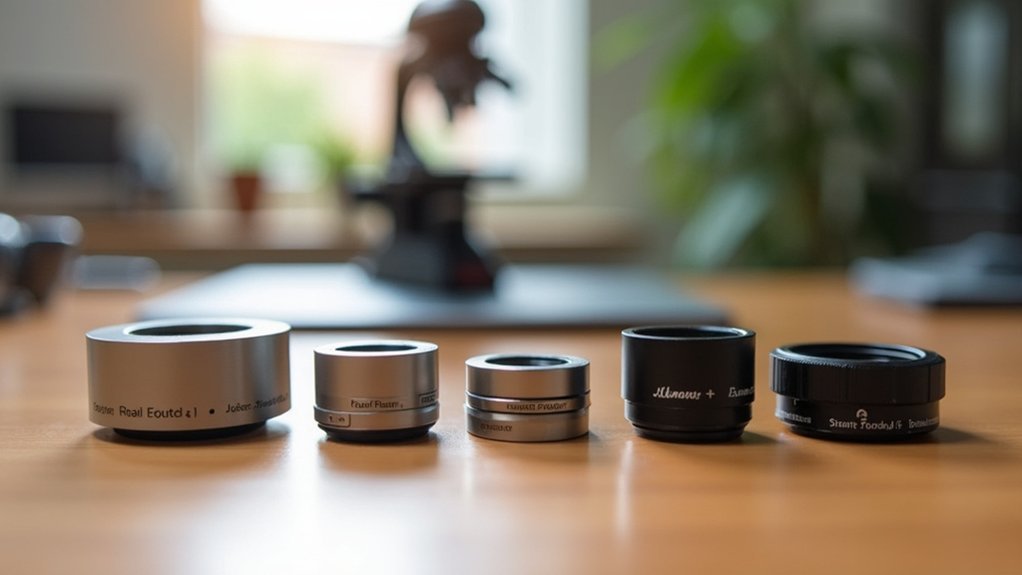
Although high-end imaging equipment often carries premium price tags, quality phase contrast microscopy doesn’t necessarily require substantial investment. The AmScope CA-NIK-SLR adapter offers an excellent budget-friendly option for Nikon SLR/DSLR camera users at just $400.
| Feature | Benefit for Phase Contrast |
|---|---|
| 2X Magnification | Maintains image clarity |
| Multi-size Compatibility | Fits 23.2mm, 30mm, 30.5mm tubes |
| Metal Construction | Enhanced durability |
| Manual Controls | Allows ideal focus adjustment |
You’ll get satisfactory phase contrast results by utilizing manual focus and exposure settings with this adapter. Its versatility makes it suitable for various microscope models while delivering professional-quality images. Despite its affordable price point, this adapter’s robust construction guarantees reliable performance in both educational and professional microscopy environments.
Advanced Adapter Features for Research-Grade Phase Contrast Imaging
Moving beyond budget solutions, research-grade phase contrast imaging demands more sophisticated adapter features to meet the exacting standards of professional laboratories.
Professional microscopy requires research-grade adapters that meet rigorous standards, not budget compromises.
You’ll benefit from advanced camera adapters that incorporate pre-centered phase contrast sliders, eliminating time-consuming re-centering procedures while ensuring consistent results.
For ideal research outcomes, look for adapters with these premium features:
- Compatible with both DSLR and mirrorless cameras to leverage high-resolution sensors
- Support for standardized magnifications (10x, 20x, and 40x objectives)
- Durable metal construction for stability and precision
- Enhanced light sensitivity and dynamic range capabilities
- Remote control and live view functionality for real-time adjustments
These research-grade adapters transform your microscope into a powerful imaging system, allowing you to capture phase contrast images with exceptional clarity while maintaining workflow efficiency.
Troubleshooting Common Adapter Issues in Phase Contrast Photography
Despite proper equipment selection, you’ll likely encounter technical challenges when integrating cameras with phase contrast microscopes. Alignment issues frequently cause poor image quality—ensure your phase contrast adapter sits perfectly in the optical path. Check that your pre-centered phase contrast slider is correctly installed to maintain proper phase ring alignment.
| Issue | Cause | Solution |
|---|---|---|
| Poor contrast | Misaligned phase rings | Realign adapter and verify phase slider position |
| Dark images | Improper exposure settings | Increase exposure time and adjust ISO sensitivity |
| Blurry output | Incompatible camera adapter | Use C-mount adapter specific to your microscope |
When troubleshooting contrast clarity problems, methodically test different magnifications (10x, 20x, 40x) while adjusting phase rings accordingly. Remember that each specimen type may require unique settings to optimize visibility of subtle refractive differences.
Step-by-Step Guide to Installing Camera Adapters for Phase Contrast
Installing camera adapters correctly is essential for achieving high-quality phase contrast images. When setting up your system, you’ll need to guarantee compatibility between your camera adapter and the microscope’s trinocular port specifically designed for phase contrast imaging.
To properly install your camera adapter:
- Remove any existing eyepiece from the trinocular head first.
- Select the appropriate adapter size (23.2mm, 30mm, or 30.5mm) for a secure fit.
- Align the adapter precisely with the microscope’s optical system.
- Verify that the pre-centered phase contrast slider is correctly positioned.
- Securely attach the adapter to prevent vibration during imaging.
After installation, fine-tune your camera settings to optimize phase contrast imaging.
Adjust manual focus and exposure settings to enhance transparent specimen visibility, guaranteeing your microscope delivers the clarity needed for detailed analysis.
Future-Proofing Your Setup: Modular Adapter Systems for Microscopy
Microscopy technology continues to evolve at a rapid pace, making modular adapter systems an increasingly valuable investment for forward-thinking researchers.
These systems allow you to upgrade your imaging capabilities without replacing your entire microscope, offering exceptional flexibility as your research needs change.
The key advantage lies in compatibility across multiple camera types—whether you’re using DSLRs, mirrorless, or C-mount cameras.
You’ll maintain versatility while exploring different imaging techniques, including phase contrast and fluorescence.
When selecting your system, utilize online configurators to match adapters precisely to your microscope model and requirements.
You can further enhance your setup by integrating specialized lighting or advanced optics accessories, ensuring consistently high-quality images.
This modular approach effectively future-proofs your microscopy investment, allowing your equipment to grow alongside emerging research demands.
Frequently Asked Questions
What Is a C-Mount Adapter?
A C-mount adapter connects your digital camera to a microscope, featuring threads that attach to the microscope and a connection for your camera. It projects microscope images directly onto your camera’s sensor.
What Type of Adapter Is Useful for Attaching Steel Cameras to the Microscope?
For attaching steel cameras to your microscope, you’ll need a C-mount adapter. These adapters provide a secure connection between your camera and microscope, ensuring stable imaging during your observations.
How Do You Attach a Camera to a Microscope?
You’ll need to select a compatible camera adapter like a C-Mount, attach it to your microscope’s trinocular head or photo port, and guarantee proper alignment between the camera’s sensor and the optical path.
What Is a Microscope Adapter?
A microscope adapter is a device you’ll attach between your camera and microscope to create a secure connection. It’ll let you capture high-quality images of specimens while ensuring proper alignment and magnification.
In Summary
When choosing a camera adapter for phase contrast imaging, you’ll need a proper C-mount adapter compatible with your microscope and camera. Confirm it maintains the correct magnification ratio for your research needs. Don’t overlook the importance of secure mounting and parfocal alignment. With the right adapter, you’ll capture crisp phase contrast images that reveal cellular details invisible to standard brightfield techniques.

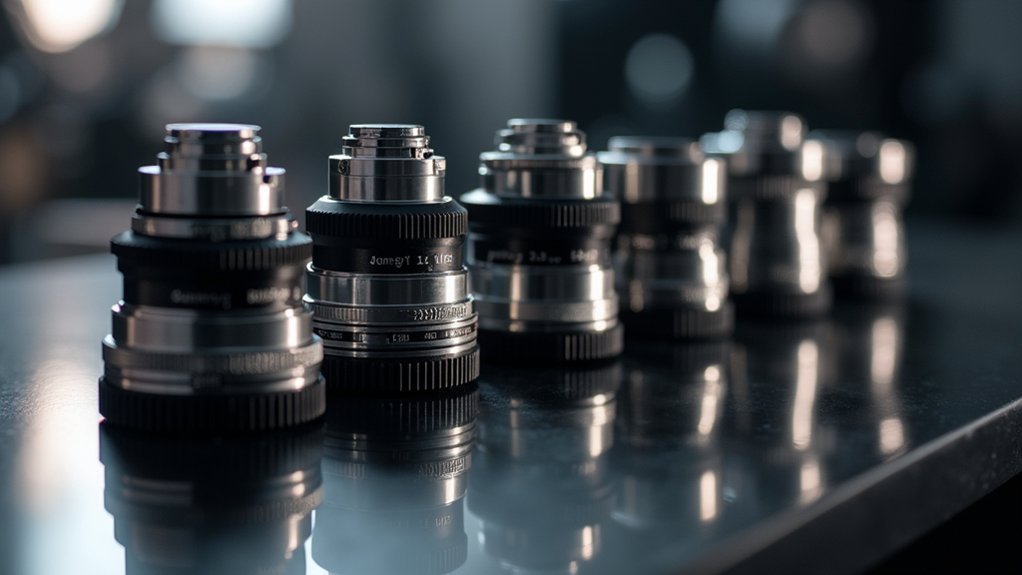



Leave a Reply